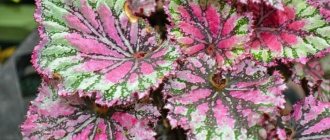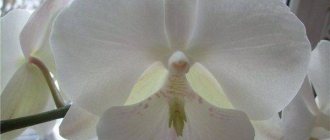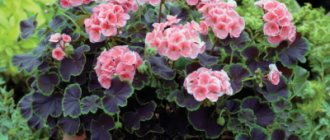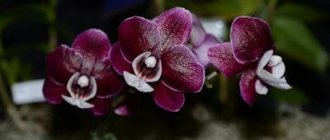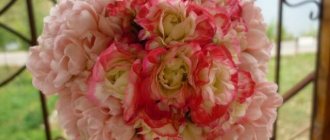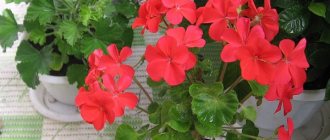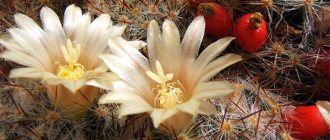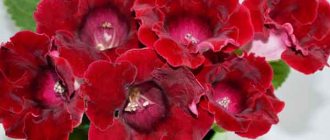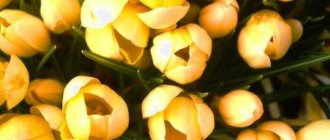Pelargonium is a genus of the highest family Geraniaceae . The three main representatives in this family Geraniaceae are, in fact, geranium, as well as pelargonium and erodia. What the whole group has in common is the presence of five petals on a long stem. Each genus can be differentiated by the number of stamens/anthers.
Erodiums have 5 stamens, pelargoniums have 7, and geraniums have 10. Geraniums also have 5 fairly symmetrical petals. The confusion between geraniums and pelargoniums was originally the fault of Swedish botanist Carl Linnaeus, who grouped the two genera into one as early as 1753, but French botanist Charles L'Hertier separated the two groups more than 30 years later.
With more species diversity, which numbers more than 200 varieties, pelargonium is an evergreen shrub with a developed root system. Most of the species have spread across all continents from South Africa, so the plant loves warmth and does not tolerate frost. Some varieties are very popular among gardeners, while other types of flowers are grown exclusively as indoor flowers.
Pelargoniums usually grow in warm regions of the temperate climate zone. The flowering period is very long, almost all summer. At the same time, flowers are absolutely not afraid of drought and heat. The flowers are predominantly purple, red, orange and white.
Good to know! Pelargoniums have many uses beyond traditional garden or window sill decoration. Many varieties have scented leaves, the aroma of which can overcome unpleasant odors. Some plants are used in cooking or to make oils. For example, the Queen of Lemons variety is used as an additive to tonic refreshing drinks. Based on extracts from pelargonium, special sprays are made that repel various insects and even some wild animals.
Care
The soil
Although pelargoniums are not particularly capricious plants, not all types of soil are suitable for them. The biggest problem for the plant is caused by poorly drained soils, when moisture can stagnate, thereby causing various diseases. Clay compounds and loams are especially dangerous. Pelargoniums grow best in peat-based soil. Soil, a third of which is sand, will also work.
Watering
Pelargonium is able to withstand significant droughts and maximum outdoor temperatures for a very long period of time. For normal growth, it is enough to water the flowers once a week. If the flower grows in southern latitudes, in winter watering can be reduced to once a month, but in the spring, starting in March, a sufficient amount of moisture can be added to the soil again.
But some cultivated and ornamental varieties require more water. In the hottest months of summer, watering should be done once every 2 days. It is important to remember that young plants always need less moisture, since their root system is not yet very developed, and the liquid will simply stagnate. Overwatering will instantly cause root rot. Also, watering must be carried out on the stem of the plant, without splashing water on the leaves and flowers. The best time to water is early morning.
Fertilizers
During the active growing season and flowering, pelargoniums need feeding. The easiest option is to add a small amount of fresh compost in the spring, scattering it around the bushes. An alternative is to fertilize with liquid potassium fertilizer, which is added to the water when watering.
Important! Pelargoniums should not be fed with fertilizers high in nitrogen. This substance will greatly stimulate leaf growth, which, in turn, will affect flowering.
Trimming
Pelargoniums need to be constantly forced to stop growing by pruning, otherwise beautiful garden plants will turn into wild bushes without flowers. As a rule, the pelargonium bush is trimmed so that it resembles a ball.
Decorative pelargoniums are prone to excessively active propagation by seeds, so every spring it is necessary to trim off new shoots that appear from the ground.
The main pruning is carried out in the fall, when the phase of active growth and flowering has already ended. Before wintering, approximately 1/3 of the leaves and all faded buds must be removed from each bush. This will ensure sufficient light penetration into the bush and good ventilation. The longest branches are pruned above the node where the leaves grow. To prevent the development of diseases after pruning, use a weak solution of a fungicide or a water mixture with a weak alkali. In spring, fresh flowers will appear at the cutting site.
Lighting
Considering the homeland of pelargonium (South Africa), the plant prefers direct sunlight throughout the day. Most breeding varieties can grow in partial shade, but it is better not to place flowers under dense tree crowns, otherwise the number of new buds will be reduced several times (unlike growing in sunny meadows). When grown at home, pelargonium should always be placed on the windowsill on the sunny side.
Temperature
The optimal temperature regime for pelargonium is +15-18 degrees Celsius. At a temperature of +10 degrees, the plant will still produce color, but if below this limit, it will gradually begin to hibernate.
Preparing for winter
Considering that most pelargoniums are perennial varieties, you will have to take care of their wintering in advance. The plant absolutely cannot tolerate temperature drops below 0 degrees Celsius; frosts on the soil will completely destroy any species or variety. Around October, before the first frost, it will be necessary to build a full-fledged greenhouse over the garden pelargonium or temporarily transplant the plant into a warm room. Covering the bushes with an additional layer of insulating materials or mulch will not give the desired effect.
Diseases and pests
Whitefly
One of the main problems of varietal pelargoniums is whitefly. However, this insect does not attack all varieties. As a rule, “citrus varieties” with fragrant leaves fall into the risk zone. The pest literally sucks the juice out of the leaves, then they darken and often begin to rot, after which the plant quickly withers and dies. Also, whiteflies can transmit viral diseases between plants.
Note ! The most effective way to get rid of insects without the use of harmful chemicals is to use a mild soap solution (dishwashing detergent is possible), which is sprayed on the plant for 2-3 weeks until the whitefly completely disappears.
Aphid
Another small insect that can cause a lot of problems for garden pelargonium. Pests eat the soft tissues of the leaves from the underside, after which they inevitably dry out. Aphids appear quite often in greenhouses, especially under oilcloth.
For prevention, they also use soap spray, spraying each bush with it. But it is best to increase the population of beneficial insects in the garden, for which aphids are food, for example, ladybugs.
Stop flowering
The main reason for the cessation of the appearance of new flowers is the appearance of so-called “dead heads” - these are testes that need to be cut off as they appear. It is not necessary to wait for them to dry completely.
Another reason for the decrease in flowers on a pelargonium bush is an excess of nitrogen in the soil. In this case, the plant will actively begin to produce new shoots and leaves. It is necessary to reduce the level of nitrogen entering the soil with fertilizers or completely transplant the plant to a new place in the garden.
Fungal diseases
Rust – can be identified as small circles of orange spores on the undersides of foliage. Rust, as a rule, appears only on zonal pelargonium. Affected leaves must be torn off and destroyed to prevent the spread of fungal spores. The bush is treated with a fungicide solution.
Gray mold - most often appears on the plant closer to autumn, when the number of warm and sunny days decreases. The most effective control for the occurrence of this disease is good ventilation, dry and warm air, and removal of all affected leaves and shoots that may be the source of the disease. To preserve the remaining bush, the cut sections of the stems must be treated with a weak whitewash solution. Only the appropriate type of fungicide will help completely get rid of the fungus.
Blackleg
Blackleg is also a fungal disease that attacks the plant from the stem and gradually spreads throughout the bush. Particular attention should be paid to fresh seedlings recently planted in the ground. Darkening at the base of the stem indicates the onset of the disease. It is not advisable to treat such bushes or seedlings, since the fungus spreads from the root. Affected specimens are destroyed.
Similar articles:
Alyssum: description of popular species, features...
Recommendations for caring for park roses, description...
Which shade-loving shrubs to choose: a review of the most...
Features of transplanting pelargonium
- Before replanting pelargonium, it is necessary to lightly trim its lower leaves.
- Carefully dig up the plant and clean the roots from the soil, allowing them to dry a little for 1-2 hours.
- To plant in a garden plot, prepare the required number of holes and a mixture of universal soil, compost and perlite. This composition will need to be buried in the plants in a new place.
- Moisten the soil slightly before planting.
- We free the lower part of the plant trunk from leaves by about 10 cm.
- Inspect the roots for rot, cut off damaged parts with pruning shears or garden shears.
- Place the plant in the hole at the same depth of the stem as it grew in the same place, and bury it with the previously prepared soil mixture.
- Water each bush thoroughly.
You can cover the ground with a thin layer of mulch on top to retain moisture until complete rooting.
Subtleties of landing
There are two methods of planting pelargonium: cuttings and seeds. At the same time, the simplest and fastest of them is cuttings. If you care for the cuttings correctly, you can quickly get a beautiful bush from it.
It is easier to plant pelargonium from cuttings
Planting cuttings and caring for them
It is recommended to wait until spring to prepare cuttings. The whole process is like this:
- cut a 5-7 cm shoot from the lateral or apical shoots of adult pelargonium;
- remove all sheets from it except the top two or three;
- leave the cutting in the air for several hours so that it dries.
In the meantime, treat the sections of the adult flower with a fungicide or, alternatively, sprinkle charcoal; Fungicides - select a small container for planting (a plastic cup is a good option), make small holes at the bottom for drainage, and fill with fresh soil;
- disinfect the soil with a special solution: one or two drops of 0.1% potassium permanganate solution per 100 ml of water;
- when the cutting dries, plant it in a prepared container with disinfected soil;
It is worth disinfecting the soil before planting using potassium permanganate - place the container with the planted cuttings where light will fall on the sprout. However, the plant should not be exposed to direct sunlight;
- Water a little at a time when the need arises. In this case, water should not be poured onto the soil, but into the pan. This is done to allow water to seep through the drainage holes;
- make sure that the plant does not stand in a place that is too cold for it (at a temperature below 15 degrees).
Pelargonium should not be in a place that is too cold
Rooting usually occurs 20-30 days after planting.
How to transplant growing pelargonium into a pot and care for it?
The algorithm is as follows.
Sequence Description
Step 1 Choose a clay pot
Its diameter should not exceed 10 cm.
Step 2 Carefully, so as not to damage the roots, remove the sprout with a small lump of earth.
Step 3 Water from a watering can with a narrow spout.
Step 4 In cloudy weather, use artificial lighting. It is better to plant pelargonium in a clay pot
It is better to plant pelargonium in a clay pot
Types of pelargonium
In total, there are more than 250 plant species in the pelargonium genus. Moreover, botanists from different countries continue to argue regarding the classification. There are only 6 cultivated species, but the number of ornamental varieties is simply enormous.
Pelargonium is zonal. The species became most widespread and was one of the first to be cultivated. It includes more than 75,000 varieties. The plant with branched, fleshy shoots and dense, rounded leaves grows quite quickly. There is a lighter spot (zone) on the leaf blade in the central part. It is surrounded by a bright border. Flowering is very abundant. Up to a dozen large umbrellas with bright colors can appear at the same time. The foliage exudes a specific aroma. The varieties are divided into thematic groups:
- Pelargonium tulipaceae. Even the blooming flowers remain quite narrow and resemble tulip buds. Each inflorescence bears a large number of flowers.
Pelargonium tulipaceae
- Terry pelargonium. Each flower has 9 or more petals:
- dovepoint - a dwarf bush with large white and pink flowers;
brookside Katerina – bright pink flowers;
- magnus is a compact, slow-growing shrub with dark green leaves that produces rich red flowers;
- saxdalens selma – abundantly blooms dense pink buds;
- wendy real – dwarf plant with salmon-pink corollas;
- sister henry – a medium-sized bush with dark green leaves that blooms dense bright pink inflorescences;
- bold gold – golden-green leaves combined with salmon buds;
- pensby - a tiny bush with dense inflorescences of soft pink buds;
- Kenny's Double is a medium-growing plant that produces many buds of crimson-red flowers at once.
- Pelargonium rosebud (rosaceous). Plants with double flowers that look like small roses.
- april snow – flowers in the form of tiny white roses with a pink border on the petals;
shelk moira - a dwarf bush covered with coral, rose-like flowers;
- anita – blooms with small white-pink flowers and grows large shiny leaves;
- vectis rosebud is a dense compact bush with bright red buds.
- Non-double pelargonium. Plants with simple five-petaled flowers.
- bob newing - angular palmate leaves have a variegated color of dark green, white and pink, flowers are solid, red.
Non-double pelargonium
Pelargonium terry
Pelargonium rosebud
Pelargonium fragrant. A shrub with branched, short shoots is covered with petiolate foliage that is round or heart-shaped. The width of the leaves reaches 5 cm. They have uneven, as if torn, edges and are covered with short pile. The leaves emit an intense, pleasant aroma. Depending on the variety, it contains notes of rose, pineapple, pine, apple, peach, etc. In May-September, multi-flowered round umbrellas with small pink or white flowers bloom, but they attract little attention.
Pelargonium fragrant
Pelargonium ivy-leaved (ampeloid). Creeping shoots grow 25-100 cm in length. They are covered with smooth, angular leaves, like ivy. Depending on the variety, the flowers are double or single. They are collected in dense inflorescences. A popular variety is green eyes - semi-double or double white-violet flowers with a green eye in the center.
Pelargonium ivy-leaved (ampeloid)
Royal pelargonium. A very beautiful, but capricious plant. It is distinguished by its large size and powerful branched shoots. The dense crown is up to 50 cm in height. The wide serrated foliage is similar to maple. Large flowers with ruffled petals grow 4-7 cm wide. The color is dominated by purple, pink, and scarlet colors. The petals are always variegated. Plants definitely need a period of rest. Flowering lasts no more than 4 months.
Pelargonium royal
Pelargonium grandiflora (large-flowered). A branched shrub up to 1 m in height is covered with lobed or dissected leaves on long petioles. The foliage is bare or slightly pubescent. Each peduncle bears 1-3 flowers with a diameter of 3-4 cm. There are red strokes on the white petals. Flowers bloom in April-June.
Pelargonium grandiflora
Pelargonium angel. The species was obtained as a result of interspecific selection. It is distinguished by smaller (1-2 cm in diameter) foliage and creeping shoots. The plant is less capricious and grows quickly. It produces simple asymmetrical flowers with larger upper petals. The mole variety produces erect, branched stems covered with light green foliage. The tops are decorated with few-flowered inflorescences with white and burgundy petals.
Pelargonium angel
Pelargonium Lady Gertrude - what kind of flower is it, what family does it belong to?
The culture was bred by European breeders. They were faced with the task of making the plant bloom in summer and autumn. At the same time, scientists tried to obtain a new type of pelargonium of small height with unusual flowering. It took them 25 years to do this.
The flower has beautiful pale pink inflorescences
For selection, ivy-leaved and hybrid varieties of geranium were used. As a result, we managed to obtain geranium of the Lady Gertrude variety. It is rarely found on sale, but is often grown by experienced gardeners.
Brief description, history of origin or selection
Pelargonium Lady Gertrude is a hybrid that has many features. The plant has an underground rhizome, on which thick and thin fragments alternate. The culture is characterized by a small number of peduncles, which are gradually covered with large pink petals. As they bloom, they take on the shape of a rose.
Lady Gertrude has large decorative leaves. At the same time, the bush itself is compact in size. It tends to grow in width, but at the same time it is quite dense. Due to this, pelargonium is given any shape.
Additional Information! The key feature of this pelargonium is the late onset of flowering. This variety is considered one of the most attractive. At the same time, it is easy to grow.
A distinctive feature of the variety is the late onset of flowering.
Reproduction
Propagation of pelargonium by cuttings
The active growth of pelargonium begins with the first rays of the sun, so cuttings can be prepared for spring planting from the end of February to mid-March. Here is a detailed description of the steps for propagating pelargonium by cuttings:
- Choose the strongest and healthiest plant to become a donor.
- Trim small branches above the junction so that 2-3 leaves remain at the end of the cutting.
- All other leaves, except the top ones, are removed.
- Next, lay the cut branches to dry a little. 2-3 hours in a warm room is enough. Just do not place the cuttings in the open sun, otherwise they will simply dry out.
- Each branch is immersed in a glass of water and placed at room temperature on a sunny windowsill.
- The formation of full-fledged roots takes on average 1 week.
Propagation of pelargonium by seeds
Growing pelargonium from seeds is a little more complicated than the cutting process. Typically, the first flowers grown from seed will appear in about 12-16 weeks. The plant can be propagated by seeds at home at any time of the year. If you then want to transfer the seedlings to open ground, it is best to start sowing in January or early February.
Detailed instructions on how to grow pelargonium from seeds are presented below.
- Pelargonium seeds have a hard outer shell, so to increase germination, you need to moisten them by leaving them for 5-6 hours (preferably overnight) in slightly warm water.
- You can significantly speed up the process of seed germination. To do this, they are laid out on a wet towel and covered with a cloth in two layers. An improvised “incubator” is placed in the sun or under a fluorescent lamp. In 1-2 days you will see the first sprouts hatching.
- For sowing, use a universal soil mixture. The container, tray or pot is pre-treated with a fungicide to prevent the appearance of fungal diseases.
- Moisten the soil until it looks like a porous sponge. Allow the moisture to be evenly absorbed into the soil for 1-2 hours.
- Make small holes in the soil (2-3 cm deep), into which place 2-3 seeds and sprinkle with soil, then water generously again.
- Pelargonium seeds do not need sunlight to germinate. A warm room with a temperature of 21 to 24 degrees Celsius is sufficient. If this temperature cannot be achieved, create a greenhouse effect by covering the tray with film or glass.
- The first shoots will appear above ground within a week.
After germination, the film/glass is removed and the young seedlings are placed on a lighted windowsill. - The seedlings will need 2-3 weeks to get stronger. During this time, take a closer look at the sprouts and gradually remove the weakest and smallest ones.
- The soil should always remain moist throughout the growing process.
Varieties of indoor plants with names and what they look like
The constant work of breeders allows us to select the most suitable type of pelargonium for certain conditions. The main differences between flowers are in size, shape of inflorescences and color of petals.
Yu-Jiga
It is a standard subspecies with a straight stem and medium dimensions. Coral inflorescences are double type, quite dense. Pelargonium Yu Jig delights every lover of house plants with its beauty.
Lake
It is unpretentious, the inflorescences have a spherical shape, salmon-colored buds, the petals of which become lighter closer to the edge. Rounded foliage with a brownish edge, the bush grows to medium size.
Rafaella F1
It is characterized by a compact appearance and a height of up to 30 cm. Suitable for keeping in rooms, loggias and flower beds. Terry buds come in milky, orange, peach, and scarlet tones. The variety was recently bred and is rarely found on the market. Easily tolerates cold and hot conditions.
Note! If the plant is properly cared for, buds will form all year round.
Pelargonium Raphaella F1
Bold Gold
It is grown outdoors and indoors. Characterized by abundant flowering. The foliage is light green in color with a ring of brownish tint located in the center. The buds are pink and red.
Minx and others
Pelargonium Lara Harmoni has double flowers with a lilac tint; its large umbrella-type inflorescences appear from the beginning of spring and fade by the end of autumn. It is distinguished by its miniature size. Pelargonium Lara Harmony has buds that resemble roses.
Minx is characterized by its small size and bright scarlet petals. Combined with dark foliage, they stand out greatly. Each variety has its own characteristics; experienced flower growers collect entire collections that differ in the growth and color of the inflorescences. Pelargonium Silk Swan is interesting for its massive stem, covered with dense leaf plates and snow-white buds.
Important! Sellers in flower shops do not always understand the culture. When purchasing, it is better to focus on Latin names
Among the indoor plants you can find:
- Pelargonium Lara Delight with medium size, fuchsia-colored inflorescences and a white core. In addition to its splendor, it is distinguished by the unusual tone of its petals. Pelargonium Lara Delight appeals to gardeners who love bright and rich colors. Plants with larger sizes or calmer bud tones are selected for the garden.
- Pelargonium Yu Disko can be found in rare cases; it is not one of the popular ones. The petals are painted in soft pinkish tones, the buds are collected in umbrella inflorescences. The spherical flowers are located on high peduncles and stand out among other crops.
- Pelargonium Yu Princess - characterized by rose-like inflorescences with a light pink tint. After some time, its petals curl into tubes, giving it an unusual appearance.
- Pelargonium Yu Kathak has an unusual color of leaf blades: the overall yellow background is emphasized by a brownish border. Inflorescences are double type, with a bright red tone. A large bush easily survives pruning.
Important! Flower shops sell plants of various subspecies (Yu Gamayun pelargonium, Yu Lilac Mist, Yu Sirin), but workers usually do not separate them. As a result, the buyer purchases a mix of geraniums of different shades
Pelargonium Minx
Appearance
Pelargonium is an evergreen perennial. Its strong herbaceous shoots branch strongly and form a subshrub. They are quite meaty. There are varieties with erect or lodging stems. They quickly increase in size. In just a year, a flower can grow by 20-30 cm. The average height of indoor plants is 60-90 cm, which is achieved by regular pruning and rejuvenation.
Pelargonium leaves are petiolate, they grow alternately. The surface of the leaf can be bare, shiny or pubescent. The color is predominantly green; there are species with variegated leaves. The shape of the leaf blades is round, heart-shaped or finger-shaped. The relief of radial veins is visible on the surface.
At home, pelargonium blooms can last almost a whole year, but most often it occurs from May to September. A rather long, bare peduncle grows in the axils of the leaves and on the tops of the shoots. It bears an umbellate, almost spherical inflorescence. Flowers on short stalks are located close to each other. They are painted in various shades of red, white and yellow. The shape of the corolla depends on the variety. Most often it consists of 5 petals, which differ in size.
After pollination, the fruits, the seed pods, ripen. A fully ripe fruit opens at the bottom, like the beak of a crane. Actually, the name “pelargonium” comes from the word “crane”.
Unique properties of geranium
Indoor geranium has unique medicinal properties. Experts have long proven that the smell of this flower relieves headaches and relieves stress.
Geranium essential oils help cure colds and improve the functioning of the upper respiratory tract. This is a fairly safe way to use a home plant - a slight touch to the leaves activates the release of fragrant essential oils from the hairs covering them.
With the help of decoctions from the leaves, you can improve the functioning of the gastrointestinal tract. This drink also helps with insomnia, joint pain and conjunctivitis, and insomnia. Such recommendations, despite the fact that they are often mentioned, should be treated with caution. Naturally, pelargonium has certain contraindications that you need to familiarize yourself with before resorting to treatment.
Are you convinced that geranium in the house is simply necessary? A houseplant that is easy to care for will decorate any room, intrigue with its aroma, and help get rid of illness. Even novice gardeners can handle caring for any type of pelargonium. If you want to acquire an ornamental plant that will bloom actively and for a long time without whims, then you should opt for pelargonium.
Reproduction methods
At home, pelargonium is propagated by cuttings and seeds. The vegetative method is used more often, since it is as simple as possible and preserves the varietal characteristics of the mother plant. Most pelargoniums require regular pruning, so material for cuttings is easy to obtain. Usually take sprouts 2-15 cm long with 1-2 nodes. The cut is made perpendicularly with a sharp blade at a distance of 5 mm from the node. If there are flowers, they are removed to reduce nutrient consumption. Large leaf blades are cut in half. It is convenient to root cuttings in water, and when roots appear, plant them in loose, fertile soil. You can immediately identify the sprouts in pots with moist, but not wet, peat. For zonal pelargonium, maintain a temperature of +20…+25°C. Angels, royals and ivies must be kept at +18°C. The rooting process takes from 2 weeks (zonal) to 3 months (royal). The first flowering can occur within six months.
To grow pelargonium from seeds, you need to first prepare the planting material. Seeds with thick skin are scarified. Then they are placed in a damp cloth for a day. Sowing is done in shallow pots with a mixture of perlite and peat to a depth of 3-5 mm. They are sprayed with water and covered with film. During the germination period, the temperature is maintained at +21…+23°C. Shoots appear in 10-15 days. After this, the shelter is removed and the container is transferred to a room with diffused bright light. When 2-3 leaves appear on the seedlings, they are picked into separate pots. Young specimens need brighter lighting, so they use backlighting.
What it is?
Rosebud geranium is a spectacular representative of double hybrids with graceful flowers collected in lush inflorescences, reminiscent of small bush roses. The color of the buds varies:
- white;
- pink;
- blue;
- red.
The flower is quite unpretentious, the main thing is to provide it with proper care:
- water and fertilize the plant in a timely manner;
- maintain the required temperature and humidity in the room.
South Africa is considered the birthplace of rosebud geranium. Back in the 18th century, the flower was brought to Europe, and in the 19th it was isolated as a separate species. The origin of rosebud geranium occurred through crossing with other species of the same crop.
Pelargonium Passat: a brief botanical description
Pelargonium Passat
The Passat variety (see photo) is a bright representative of dwarf zonal pelargoniums, which is closer in size to miniature specimens. The decorative color of the leaves with a dark ring is best seen with sufficient lighting, so it is better to keep the plant on a sunny windowsill, protected from direct rays.
The inflorescences also deserve attention - thanks to their soft pink color with a salmon tint and corrugated petals, they look very impressive. The Passat variety boasts dense, densely stuffed terry caps, which rise above the crown during budding. In favorable conditions, pelargonium blooms profusely and can produce up to 36 peduncles; in the sun, the flowers “tan” and the color of the petals becomes more saturated.
Passat blooms early - the first caps appear at the stage of young cuttings, but pelargonium reveals its full potential with age, after 2 years of cultivation. For active growth of green mass, regular fertilizing during the active growing season is required, as well as pruning and pinching, which stimulate the appearance of side shoots. During the winter, the bush practically does not grow, which makes it possible to maintain a suitable crown shape all year round.
Since Passat pelargonium is a dwarf variety, planting in spacious pots is not carried out. Flowerpots about 12 cm in diameter are recommended - this will allow the plant to grow a crown and bloom, rather than waste energy on developing an earthen clod. In addition, in large containers the risk of flooding increases significantly.
Passat is a varietal pelargonium, therefore it reproduces not by seed, but by vegetative means. As a rule, to obtain young specimens, cuttings are used after spring pruning, rooting them in a light substrate made of a mixture of peat and perlite.
Growing
Peculiarities:
- the flower is grown in spacious pots, but not in open ground;
- pelargoniums do not tolerate bad weather - gusty winds, rain, cold and fog are destructive for them;
- flowers love the sun, but you shouldn’t leave them in the heat under the scorching rays;
- in winter, most varieties are dormant, they lose their decorative effect, stretch out and stop blooming;
- It is not advisable to place plants near heating radiators in winter;
- from the beginning of the growing season, the bushes need to be shaped by proper pruning of the shoots;
- faded roses need to be removed - then the whole bunch will continue to bloom;
- Rosebud pelargoniums are fertilized with phosphorus-potassium fertilizers.
The soil
In order for a plant to please the grower with its flowering, it is necessary to choose the right soil for it. The soil should be loose, nutritious, and have neutral acidity. We must not forget about good drainage - 1/3 of the pot is filled with expanded clay.
It is recommended to use the following composition:
- agroperlite – 1/10 part;
- sand – 1/10 part;
- humus – 2/10 parts;
- peat – 2/10 parts;
- turf soil - 4/10 parts.
Lighting
For rosebud pelargoniums, southern and southwestern windows are best suited. If this is not possible, then you need to provide the plants with special phytolamps. In very hot weather, when the air temperature reaches +30 degrees, the sun can burn the leaves of plants. On the street it is better to move them to partial shade, and in the house to protect them from the rays with curtains.
Temperature
In summer, the optimal temperature for this plant is considered to be from +20 to +25 degrees. In winter it should be at least +15 degrees.
Watering
In its homeland in Africa, this plant species lives in arid soils rich in limestone, calcium and chalk, so the plants tolerate drought well and suffer from waterlogging. Plants should not be watered too much. This should only be done when the top layer of soil is completely dry. In winter, watering is reduced.
Plants do not like spraying, like all varieties with pubescent leaves. Pelargoniums need to be watered carefully so as not to soak the roses. The water must be soft, standing for at least 24 hours.
Landing
Appleblossom, like all pelargoniums, reproduces vegetatively: shoots and seeds. If the pelargonium variety is hybrid, then it is not worth propagating it by seeds. Classic varieties, on the contrary, give excellent results when sown.
